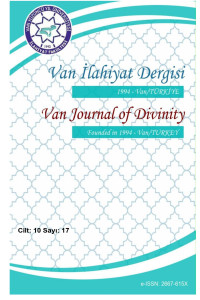Research Article
Issue Editorial Board




Aim & Scope
Van İlahiyat Dergisi - Van Journal of Divinity is a peer-reviewed Journal published twice a year as July and December. It aims to publish scientific research such as papers, book reviews and symposium reviews on religious studies and to share these studies with public. VANİD provides articles written by qualified specialists in the area of Islamic Studies (Scope: Arts and Humanities/Religion/Islamic Studies & Scope: Social and Behavioral Sciences/ Theology and Ethics). It continues to publish compelling original research articles that contribute to the development of scholarly understanding and interpretation in the history and philosophy of religious thought in all traditions and periods - including the areas of Islamic Studies.
Van İlahiyat Dergisi - Van Journal of Divinity continues to publish compelling original research that contributes to the development of scholarly understanding and interpretation in the history and philosophy of religious thought in all traditions and periods - including the areas of Islamic Studies, Judaic Studies, Christianity, Comparative Religious Studies, Theology and Ethics.
Scope: Arts and Humanities/Religion/Islamic Studies/Comparative Religious Studies
Scope: Social and Behavioral Sciences/ Theology and Ethics
Author Guidelines
WHAT WE LOOK FOR IN YOUR ARTICLE?
Van İlahiyat Dergisi – Van Journal of Divinity is a peer-reviewed Journal published twice a year as June and December.
Van İlahiyat Dergisi – Van Journal of Divinity does not charge any article submission, processing charges, and printing charge from the authors.
We consider for publication in jour ournal published articles which:
Report original science, and add significantly to research already publishedare of interest to the community
are scientifically rigorous
have sound motivation and purpose
have not been published previously in the peer-reviewed literature, including in another language
are not under consideration for publication in any other peer-reviewed journal or book available through a library or by purchase.
It is particularly important for authors to consider whether they have enough new results before starting to plan and write a paper for submission. Reporting incremental steps forward from previous work is not good enough.
Articles based on theses for higher degrees may be submitted, although authors should take care that such articles are prepared in the format of a research paper, which is more concise than is appropriate for a thesis.
Articles reporting work that was originally presented at a conference may be submitted, provided these articles do not appear in substantially the same form in a peer-reviewed, published conference proceeding. Again, authors should take care to ensure the format of a research paper is used. The article length should also be appropriate to the content. In case of doubt, please enquire with the journal.
All articles are judged solely on their scientific merits. Unbiased consideration is given to all manuscripts offered for publication regardless of whether or not the authors request publication on an open access basis and regardless of the race, gender, religious belief, ethnic origin, citizenship, political philosophy, sexual orientation, age or reputation of the authors.
We treat all submitted articles as confidential until they are published and they will only be shared with those referees, Board members, Editors and Vanid staff who are directly involved in the peer review of the article.
How to prepare your article
Before submission please check the individual journal homepage for information on the journal’s subject scope, available article types, specific manuscript length limits and details of any variations to the peer review process that might apply.
General
Vanid aims to be flexible and to make submission as easy as possible for authors. We only require a PDF file of the new article (and any suitable supplementary data files) on submission. Authors are asked to submit at revision stage the source files used to create their PDF (to assist with accurate typesetting), the text of which can be in either Microsoft Word or TeX/LaTeX. Our online submission form also allows authors to collect and directly upload their article from the arXiv and to upload other compressed or archived files.
Authors can format their papers in the way that they choose. It is not necessary to try to produce pages that look like published journal pages, as the detailed design (typesetting) work will be undertaken by Vanid as part of the production process. However we do ask that authors consider the readability for referees when formatting their manuscripts. For example, please use a reasonable font size (at least 10 point) and line spacing. There is no need for authors to include line numbers in their manuscript as these will automatically be added on submission. Figures and tables should be embedded at the appropriate point within the text, rather than placed at the end of the manuscript. Papers must be written in Turkish or English.
Length of submissions
Most journals have guidelines for the maximum recommended length for each different type of article, as detailed in the scope statement available from that journal’s homepage. It is important that you check these guidelines when preparing your submission. Articles which are longer than the length limit may still be considered for publication provided that the length is clearly justified by the scientific content.
Article structure
Your article should normally consist of the following sections and should follow the Introduction, Methods, Results and Discussion system:
a title page with the title of the article, name(s) of author(s) and address(es) of establishment(s) where the work was carried out
an abstract
an introduction
a methods section
a results section
a discussion section
a conclusion section
an acknowledgments section
a list of references
The following sections give a brief overview of the main elements of an article. Please read these first. You can find more detail in our LaTeX and Word guidelines which are presented in the style of a typical article, and offer suggestions on how to format a manuscript.
Title page
Title of article
The title should be concise, informative and meaningful to the whole readership of the journal. Please avoid the use of long systemic names and non-standard abbreviations, acronyms or symbols.
Authors and addresses
Author lists should be finalised prior to submission (for more information on this please consult our Ethical Policy for Journals). For articles with several authors, please list the names of all the authors first, followed by the full postal addresses, using superscript numeric identifiers to link an author with an address where necessary.
ORCID
We encourage you (and your co-authors) to register for an ORCID identifier and connect it to your account in our submission and peer-review system. This uniquely identifies you and connects you to your publication. This will help ensure you get credit for your work, improve its discoverability, and help us streamline the publishing process.
ORCID identifiers supplied in this way will be included in published manuscripts, and the publication lists in your ORCID record will then be automatically updated via Crossref. (You will need to grant permission to Crossref the first time; this will be requested via your ORCID inbox.)
Abstract
Your abstract should give readers concise information about the content of your article. It should be informative, accessible and not only indicate the general scope of the article but also state the main results obtained and conclusions drawn. The abstract should be complete in itself - no table numbers, figure numbers, references or equations should be referred to. It should be suitable for direct inclusion in abstracting services and should not normally be more than 150 words.
Main text
It is helpful for readers if your article is concise, but clarity is essential. Short sentences and paragraphs make reading easier. You should aim for consistency within your article in matters such as hyphenation and spelling.
All acronyms and abbreviations should be clearly explained when they first appear in the text, and all units used should be consistent throughout the article.
Article structure
Introduction: This should be concise and describe the nature of the problem under investigation and its background. It should also set your work in the context of previous research, citing relevant references. Introductions should expand on highly specialised terms and abbreviations used in the article to make it accessible for readers.
Methods: This section should provide sufficient details of the experiment, simulation, statistical test or analysis carried out to generate the results so that the method can be repeated by another researcher.
Results: The results section should detail the main findings and outcomes of your study. You should use tables only to improve conciseness or where the information cannot be given satisfactorily in other ways such as histograms or graphs. Tables should be numbered serially and referred to in the text by number (table 1, etc.). Each table should have an explanatory caption which should be as concise as possible.
Discussion: This should discuss the significance of the results and compare them with previous work using relevant references.
Conclusion: This section should be used to highlight the novelty and significance of the work, and any plans for future relevant work.
Acknowledgments
All authors and co-authors are required to disclose any potential conflict of interest when submitting their article. This information should be included in an acknowledgments section at the end of the manuscript. All sources of financial support for the project must also be disclosed in the acknowledgments section.The name of the funding agency and the grant number should be given, for example: 'This work was partially funded by the National Institutes of Health (NIH) through a National Cancer Institute grant R21CA141833.'
When completing the online submission form, we also ask you to select funders (from the FundRef Registry) and provide grant numbers in order to help you to meet your funder requirements. For more information about FundRef, please see: crossref.org/fundref.
References
It is vitally important that you fully acknowledge all relevant work. You should also consult our Ethical Policy for Journals for general guidance on compiling your reference list.
A reference should give your reader enough information to locate the article concerned and should consist of:
author name(s) and initials
year of publication
title of the journal or book
the volume number
for books: town of publication and the name of the publisher
and finally the article number or page numbers.
Where there are up to ten authors, all authors’ names should be given in the reference list. Where there are more than ten authors, only the first name should appear, followed by et al.
You should take particular care to ensure that the information is correct so that links to referenced articles can be made successfully. Material which is really a footnote to the text should not be included in the reference list, which should contain only references to bibliographic data. Copies of cited publications not yet available publicly should be submitted for the benefit of the referees. Unpublished results and lectures should be cited for exceptional reasons only. Before submitting your article, please ensure you have done a literature search to check for any relevant references you may have missed.
Reference systems
Van İlahiyat Dergisi – Van Journal of Divinity requires writers to use the Isnad Citation Style: http://www.isnadsistemi.org
First citation: author(s) first name and last name, title, (if applicable) first and last name of translator or editor, place of publication, publisher, date of publication, page number.
Subsequent citations: author’s last name, the short title, and the page number should be indicated in all subsequent citations. Footnote citations should conform to the following examples.
References: References should be placed at the end of the text in alphabetical order. If a source has more than one author, the surname, and name of the first author should be written, and the other authors should be indicated by et.al. The titles of books and journals should be italicized; article titles and book chapters should be placed in quotation marks. Translator’s and editor’s names (if there are any) should follow the title of the work:
BOOK
a) One Author:
1. Michael Pollan, The Omnivore’s Dilemma: A Natural History of Four Meals (New York: Penguin, 2006), 99–100.
2. Pollan, Omnivore’s Dilemma, 3.
Bibliography:
Pollan, Michael. The Omnivore’s Dilemma: A Natural History of Four Meals. New York: Penguin, 2006.
b) Two Authors
1. Geoffrey C. Ward and Ken Burns, The War: An Intimate History 1941–1945 (New York: Knopf, 2007), 52.
2. Ward and Burns, War, 59–61.
Bibliography:
Ward, Geoffrey C., and Ken Burns. The War: An Intimate History 1941–1945. New York: Knopf, 2007.
c) Three or More Authors
For three or more authors, list all of the authors in the bibliography; in the note, list only the first author, followed by et al. (“and others”):
1. Mitchell L. Eisen, Jodi A. Quas, and Gail S. Goodman, eds., Memory and Suggestibility in the Forensic Interview (Mahwah, NJ: L. Erlbaum Assoicates, 2002), 65.
2. Eisen and et al., Memory and Suggestibility in the Forensic Interview, 67.
Bibliography:
Eisen, Mitchell L., Jodi A. Quas, and Gail S. Goodman, eds. Memory and Suggestibility in the Forensic Interview. Mahwah, NJ: L. Erlbaum Associates, 2002.
d) Translation
1. Gabriel Garcia Marquez, Love in the Time of Cholera, trans. Edith Grossman (London: Cape, 1988), 242–55.
2. Marquez, Cholera, 33.
Bibliography:
Marquez, Gabriel Garcia. Love in the Time of Cholera. Translated by Edith Grossman. London: Cape, 1988.
e) Chapter or Other Part of a Book
1. John D. Kelly, “Seeing Red: Mao Fetishism, Pax Americana, and the Moral Economy of War,” in Anthropology and Global Counterinsurgency, ed. John D. Kelly et al (Chicago: University of Chicago Press, 2010), 77.
2. Kelly, “Seeing Red,” 81–82.
Bibliography:
Kelly, John D. “Seeing Red: Mao Fetishism, Pax Americana, and the Moral Economy of War.” In Anthropology and Global Counterinsurgency, edited by John D. Kelly, Beatrice Jauregui, Sean T. Mitchell, and Jeremy Walton, 67–83. Chicago: University of Chicago Press, 2010.
ARTICLE
a)Printed
1. Joshua I. Weinstein, “The Market in Plato’s Republic,” Classical Philology 104 (2009): 440.
2. Weinstein, “Plato’s Republic,” 452–53.
Bibliography:
Weinstein, Joshua I. “The Market in Plato’s Republic.” Classical Philology 104 (2009): 439–58.
b) Online
1. Gueorgi Kossinets and Duncan J. Watts, “Origins of Homophily in an Evolving Social Network”, American Journal of Sociology 115 (2009): 411, accessed February 28, 2010, doi:10.1086/599247.
2. Kossinets and Watts, “Origins of Homophily,” 439.
Bibliography:
Kossinets, Gueorgi, and Duncan J. Watts. “Origins of Homophily in an Evolving Social Network.” American Journal of Sociology 115 (2009): 405–50. Accessed February 28, 2010. doi:10.1086/599247.
ENCYCLOPEDIA ENTRIES
For encylopedia entries, the author’s name and surname are written first. These are followed by the title of the entry in quotation marks, the full name of the encyclopedia, , the place and date of publication, its volume number and page numbers:
1. As’ad Abukhalil, “Maronites,” in Encyclopedia of the Modern Middle East and North Africa, ed. Philip Mattar, 2nd ed., vol. 3 (New York: Macmillan Reference, 2004), 1491-92.
2. Abukhalil, “Maronites,” 1492.
Bibliography:
Abukhalil, As’ad. “Maronites.” In Encycloedia or the Modern Middle East and North Africa. Edited by Philip Mattar. 2nd ed. Vol. 3. New York: Macmillan Reference, 1491-92.
DISSERTATION
For theses and dissertations, the following order should be followed: name of the author and surname, full title of thesis in italics, thesis type, the name of the university and date.
1. Mihwa Choi, “Contesting Imaginaires in Death Rituals during the Northern Song Dynasty” (PhD diss., University of Chicago, 2008), 55.
2. Choi, “Contesting Imaginaires,” 59.
Bibliography:
Choi, Mihwa. “Contesting Imaginaires in Death Rituals during the Northern Song Dynasty.” PhD diss., University of Chicago, 2008.
The Isnad Citation Style: http://www.isnadsistemi.org
Figures
Carefully chosen and well-prepared figures, such as diagrams and photographs, can greatly enhance your article. We encourage you to prepare figures that are clear, easy to read and of the best possible quality. Characters should appear as they would be set in the main body of the article. We will normally use figures as submitted; it is, therefore, your responsibility to ensure that they are legible and technically correct.
How to submit a new article
Please submit all new articles via the 'Submit an article' link on the journal homepage. Please ensure that you enter all the required information about your article and all its authors before uploading your files. You are required to select some keywords for your article. Please note that, if your article is accepted for publication, we will display these keywords on the published article. Authors may propose preferred (and non-preferred) referees on submission. The suggested referees should have suitable subject expertise and not have any conflicts of interest (please see the Peer Review policy for further information on conflict of interest). These suggestions will be considered; however, the editorial staff and/or the Editorial Board will make the final decision regarding referee selection.
If you are a new author, you will need to set up an author account before submitting your first article. Using the Author Centre, you will be able to track the progress of your article, respond to the referee reports, and submit your revised version.
When submitting a new article, we only require you to upload a single PDF file and any relevant supplementary data at this stage. The PDF should contain your complete manuscript, including any embedded figures and tables. You may upload your article from the arXiv directly by entering the arXiv e-print number. Please also submit any permissions that you have already obtained at this stage.
If you experience any problems submitting your article online, please contact the journal team for assistance: vanyyuifd@yyu.edu.tr
How to prepare your revised article
It is common for our referees to request that authors make revisions to their articles. If you are asked to submit a revised version of your article, in addition to article files, we require a list of changes made and a point-by-point response (even if you disagree) to each referee comment before we consider the revision. We recommend that authors copy each referee comment into a separate document and add a response below each comment (and refer to the manuscript line numbers when referring to changes in the main text) to assist our staff and referees with checking revisions as quickly as possible. If the referee(s) and Editorial Board are not satisfied with the changes to your manuscript, it may still be rejected at this stage. Please make sure that you send your revised article to us and not simply the original version again. By observing these guidelines you will be assisting the referees, who give up their time to review manuscripts.
How to submit a revised article
Please submit all revised submissions via the link in the e-mail you received informing you of the decision and asking you to make the revisions.
When submitting a revised article, we require you to upload the revised PDF file (deleting the original version) and your latest set of source files used to create the revised PDF. In addition, you will need to submit your point-by-point response to the referees. You will subsequently be asked to complete and submit the online assignment of copyright form if you have not done so already.
If you experience any problems submitting your article online, please contact the journal team for assistance: vanyyuifd@yyu.edu.tr
What we do with articles after acceptance
After acceptance your article will be copy-edited and typeset, using the source files that you have provided, and a proof will be produced.
Proofs
We will contact you by e-mail when the PDF proof of your article is ready for you to check.
You should check your proof carefully and return corrections using the web page provided. This is the most efficient way to send them to us. Please supply an annotated PDF file using the strikethrough, replacement text and insert text functions. For other changes, please add a sticky note. Please ensure all changes are visible via the ‘Comments’ list in the annotated PDF so that your corrections are not missed.
Please do not resupply a new source file because it is difficult to identify corrections and some could be missed.
The ultimate responsibility for ensuring the accuracy of the published article rests with you. If proofs reach you during an absence of which we have not been informed, or if the proofs are not returned sufficiently quickly, we may publish the article without your corrections.
When checking your proofs you should take particular care checking mathematics, tables, and references. Only essential corrections should be made. You should provide new files if figures need correction. We recommend that you check the accuracy of your original diagrams very carefully before submission; we cannot accept responsibility for any errors in original diagrams.
Ethical Principles and Publication Policy
Ethical Principles and Publication Policy Van Journal of Divinity is published by Van Theology Faculty.
Van Journal of Divinity publishes academic studies about Religion, Philosophy, History as a priority in the field of Social Sciences and Humanities. Van Journal of Divinity accepts academic studies such as research article, translation, book review, symposium review, and doctoral thesis summary. The publication language of Van Journal of Divinity is Turkish. But there can be English, German, French, Arabic, and Persian articles in order to not exceed %40 of the total articles. Ph.D. students, as a single author; graduate students with the supervisor –first author student; second author supervisor- can send their work to Van Journal of Divinity. In the case of book review, only the studies which written by someone who has a doctorate degree are examined. Van Journal of Divinity is published twice a year, in print and online, on June and December. 1 January - 15 May for the issue dated June; For the issue dated December, manuscript is accepted between 1 July - 15 November. In the first page of the study, there must be the author’s name, institution name, ORCID, and a phone number suitable to the ISNAD Citation Style. For the articles and translation studies, the upper limit of words are 9.000, for other studies, the upper limit of words is 1500. Permission letter/mail which taken from the author of translation articles should be added. During application, 150-200 words Turkish abstract, 150-200 words English abstract and at least 5 Turkish and English keywords should be written. After the referee evaluation, it is requested to expand the öz (Turkish)/abstract (English) part of the articles to 500-600 words. Studies should be written as given at least 2,5 cm margins, written in Times News Roman font, 12 pt. and 1,5-row pitch; footnotes should be written as 10 pt. and single line pitch. In the citation and bibliography of the studies, the ISNAD Citation Style should be used: www.isnadsitemi.org
The name of the author, the name of the work and the spelling of the TDV Islamic Encyclopedia should be taken as a basis for writing the concepts: TDV Islamic Encyclopedia Article List The online version of Van Journal of Divinity is open access, excluding commercial use. OAI: ttps://dergipark.org.tr/tr/pub/vanid
All copyrights of the articles published in our journal belong to their authors. The authors fully own the copyright of their work published in Van Theology Journal and agree to publish their work as open access under the Creative Commons Attribution-NonCommercial 4.0 International (CC BY-NC 4.0) license.
Scientific, intellectual, and literary responsibilities of published articles belong to their author. Open Access Policy: Van Journal of Divinity; Adopting the principle that providing scientific research free of charge to the public will increase the global sharing of information, it provides instant open access to individual users, and is offered to legal entities for a fee. Archiving: The journal is archived electronically by the Editorial Board. Publication and Evaluation Fee: Van Journal of Divinity does not charge any fee from the authors for the article evaluation and publication process. No fee is paid to the authors. Ethical Rules
The publication process at Van Journal of Divinity is the basis of the improvement and dissemination of information objectively and respectfully. Therefore, the procedures in this process improve the quality of the studies. Peer-reviewed studies are the ones that support and materialize the scientific method. At this point, it is of utmost importance that all parties included in the publication process (authors, readers, and researchers, publishers, reviewers, and editors) comply with the standards of ethical considerations. Van Journal of Divinity expects all parties to hold the following ethical responsibilities.
List of references, financial support;
No plagiarism, no fraudulent data;
Forbidden to publish the same research in more than one journal.
Authors obliged to participate in the peer-review process;
All authors have significantly contributed to the research;
Statement that all data in article are real and authentic;
All authors are obliged to provide retractions or corrections of mistakes.
Judgments should be objective;
Reviewers should have no conflict of interest with respect to the research, the authors and/or the research funders;
Reviewers should point out relevant published work which is not yet cited;
Reviewed articles should be treated confidentially.
Editors have complete responsibility and authority to reject/accept an article;
Editors should have no conflict of interest with respect to articles they reject/accept;
Only accept a paper when reasonably certain;
When errors are found, promote the publication of correction or retraction;
Preserve the anonymity of reviewers.
No plagiarism, no fraudulent data.
Monitoring/safeguarding publishing ethics by editorial board;
Guidelines for retracting articles;
Maintain the integrity of the academic record;
Preclude business needs from compromising intellectual and ethical standards;
Always be willing to publish corrections, clarifications, retractions, and apologies when needed.
The following ethical duties and responsibilities are written in the light of the guide and policies made by the Committee on Publication Ethics (COPE).
1. Publication and authorship:
2. Author’s responsibilities:
3. Peer review/responsibility for the reviewers:
4. Editorial responsibilities:
5. Publishing ethics issues
Duties of the Publisher
Van Journal of Divinity is committed to ensuring that commercial revenue has no impact or influence on editorial decisions. In addition, ULUM will assist in communications with other journals and/or publishers where this is useful to editors. Finally, we are working closely with other publishers and industry associations to set standards for best practices on ethical matters, errors, and retractions–and are prepared to provide specialized legal review and counsel if necessary.
Plagiarism Detection
Van Journal of Divinity uses a double-blind review fulfilled by at least two reviewers. In addition, all articles are checked by means of a program in order to confirm they are not published before and avoid plagiarism.
The peer-review process is at the heart of the success of scientific publishing. As part of our commitment to the protection and enhancement of the peer review process, Van Journal of Divinity has an obligation to assist the scientific community in all aspects of publishing ethics, especially in cases of (suspected) duplicate submission or plagiarism.
When a reader discovers a significant error or inaccuracy in a paper published in Van Journal of Divinity have any other complaint about editorial content (plagiarism, duplicate papers, etc.), he/she should make a complaint by e-mail to vanyyuifd@edu.tr
We welcome complaints as they provide an opportunity for improvement, and we aim to respond quickly and constructively.
Publishing Ethics Resource Kit
Committee on Publication Ethics (COPE)
What to do if you suspect peer review manipulation
How to recognize potential authorship problems
Suspected fabricated data in a submitted manuscript
How to spot authorship problems
Suspected ghost, guest or gift authorship
Price Policy
Makale gönderim işlemleri ücretsizdir.
Indexes
Citation Indexes
Other Indexes
Journal Boards
Concessionaire

Editor -in- Chief







 Web
Web
Editor

Editorial Board










 Web
Web



 Web
Web





 Web
Web
Science and Advisory Board




Subject Editor












 Web
Web






Writing Editors



Final Reading

Layout Editor

Secretary

Managing Editor







 Web
Web
Statistical Editor

Foreign Language Editors















